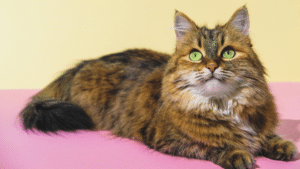The skin is the largest organ of the body. Depending on the species and age, the skin may be 12 to 24% of a pet’s total body weight. The skin is also one of the most important organs of the body as it forms a barrier to protect both the cat from infections, parasites, and the elements.
The Importance of the Skin and Hair-coat
One of the skin’s most important functions is to maintain the body’s internal environment, preventing the loss of moisture and other body constituents and providing them with its sense of pressure and touch. Because the skin is on the outside of the body, it is easily exposed to environmental elements and quite susceptible to injury and disease.
A cat’s coat is comprised of three layers: the outer guard hairs, the middle awn hairs, and the soft down hairs closest to the skin. Each layer has its own unique characteristics and functions.
The outer guard hairs, also known as the primary hairs, are the longest and coarsest hairs in a cat’s coat. These hairs act as a protective barrier against the elements, such as rain, snow, and UV rays. They help to keep a cat dry and shielded from harmful sun exposure.
The middle awn hairs, also referred to as the secondary hairs, provide insulation for the cat’s body. These hairs are slightly shorter and softer than the guard hairs. They help to trap air close to the skin, creating a layer of warmth that keeps your cat cozy in colder temperatures.
The soft down hairs are the shortest and finest hairs in a cat’s coat. These hairs are responsible for providing additional insulation and helping to regulate body temperature. They also contribute to the softness and fluffiness of your cat’s coat.

Identifying your cat’s coat type is crucial for proper grooming and maintenance. For example, a short-haired cat may require less frequent brushing compared to a long-haired cat. Short-haired cats typically have coats that are easier to maintain and are less prone to matting. However, regular brushing is still important to remove loose hair and prevent hairballs.
A long-haired cat requires more extensive grooming due to their luxurious and often dense coats. Regular brushing is essential to prevent matting and tangles, which can be uncomfortable and even painful.
Some cats have a double coat with a dense undercoat beneath their longer guard hairs. Double-coated cats, such as the Maine Coon and the Siberian, require regular brushing to control shedding and prevent matting.